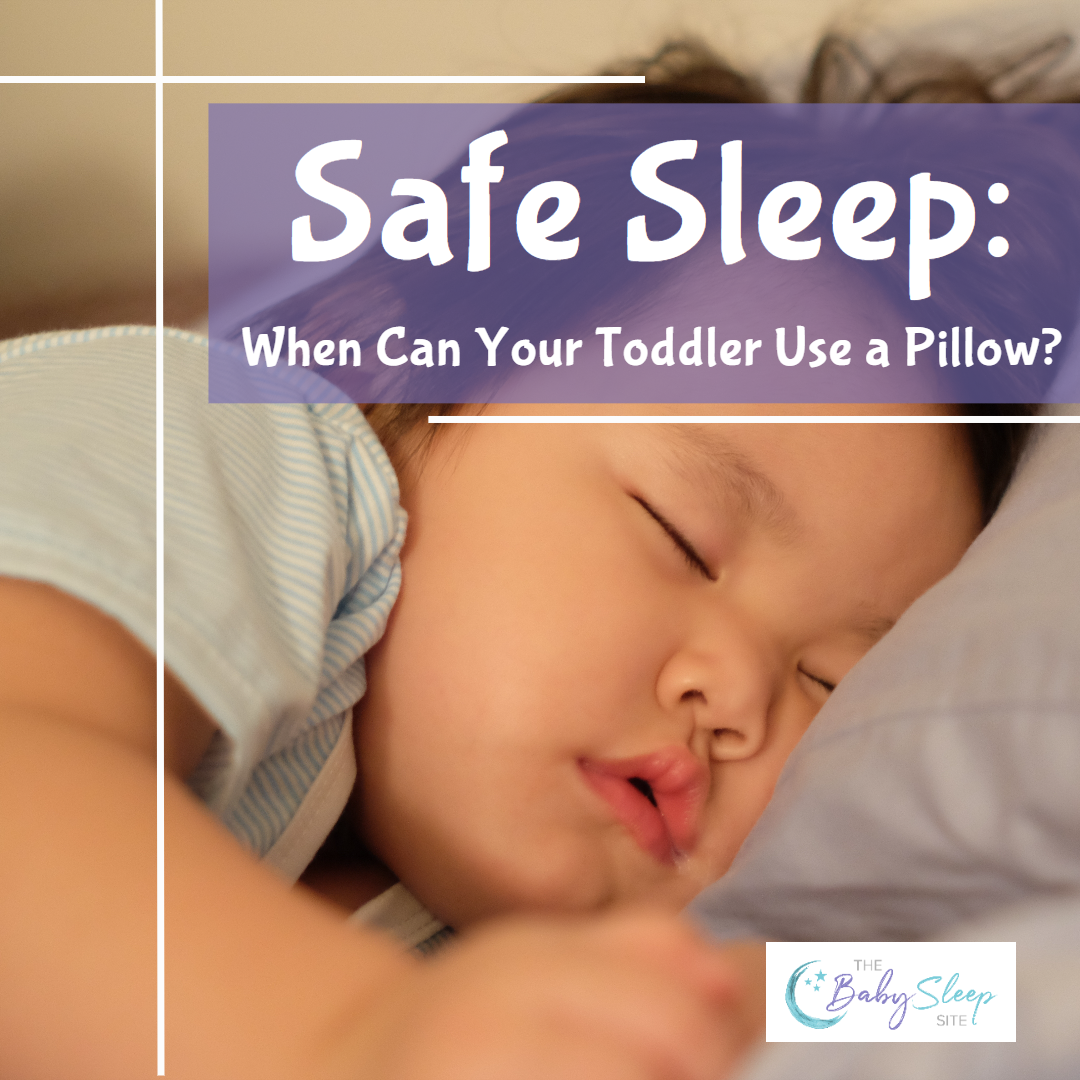When can a toddler use a pillow? Most pediatricians recommend introducing a pillow to a toddler’s sleep environment around 18 months to 2 years of age. However, this milestone depends heavily on your child’s individual development, motor skills, and overall sleep safety. This article will explore the critical factors in determining the appropriate toddler pillow age, toddler pillow safety, when to introduce pillow to toddler, and how to choose the safe pillow for toddler.

Image Source: www.babysleepsite.com
Deciding When to Introduce a Pillow
It’s natural to want your little one to be as comfortable as possible. However, safety always comes first when it comes to sleep.
Key Considerations
Several factors play a role in determining when your toddler is ready for a pillow:
- Motor Skills: Can your toddler move their head and neck freely and easily? If they get into an uncomfortable position, can they adjust themselves? These are critical abilities.
- Developmental Stage: Are they transitioning from a crib to a toddler bed? This transition often coincides with introducing a pillow.
- Overall Health: Do they have any respiratory issues or reflux? A pillow could potentially worsen these conditions in very young children. Consult with your pediatrician if you have concerns.
Why Delaying Might Be Best Initially
Initially, a bare crib or bed is the safest sleep environment for infants and young toddlers. This is to minimize the risk of Sudden Infant Death Syndrome (SIDS) or suffocation. Soft items like pillows, blankets, and stuffed animals can pose hazards.
The Right Time: Signs Your Toddler Might Be Ready
While the general guideline is around 18 months to 2 years, observe your child for these signs they might be ready for a pillow:
- Using a Blanket or Toy as a Pillow: Do you often find them resting their head on a blanket, stuffed animal, or even their arm while sleeping?
- Restlessness at Night: Are they tossing and turning, seemingly trying to get comfortable?
- Expressing a Desire for a Pillow: Older toddlers might verbally ask for a pillow, especially if they see other family members using them.
- Transitioning to a Bed: With a bigger bed, a pillow can provide better support.
Pillow Safety: What You Need to Know
Once you decide to introduce a pillow, safety should remain your top priority.
Minimizing Risks
- Suffocation: A pillow that is too thick or firm can pose a suffocation risk, especially if the toddler rolls onto their stomach.
- Allergies: Some pillow materials can trigger allergies.
- Improper Spinal Alignment: A pillow that is too high can misalign the spine and cause neck pain.
Essential Safety Guidelines
Follow these guidelines for toddler pillow safety:
- Start Small: Begin with a very thin, flat pillow.
- Choose Hypoallergenic Materials: Opt for pillows made from hypoallergenic materials like cotton or bamboo.
- Avoid Pillows with Filling That Can Shift: These can create uneven surfaces.
- Regularly Inspect the Pillow: Check for tears, loose seams, or any other damage.
- Wash the Pillow Frequently: This helps to remove dust mites and allergens.
- Monitor Your Toddler’s Sleep Position: Watch how they interact with the pillow and adjust accordingly.
Selecting the Right Pillow: Features and Considerations
Choosing the best pillow for 2 year old (or any toddler) requires careful consideration.
Key Features to Look For
- Thin Profile: The pillow should be no more than 2-3 inches thick.
- Firmness: It should be relatively firm to provide support without being too soft.
- Size: A smaller pillow is easier for a toddler to manage. Think of a pillow around 13×18 inches for pillow size for toddler.
- Material: Choose breathable, natural materials like cotton or bamboo. Avoid pillows with small parts that could be a choking hazard.
- Washability: The pillow should be easy to wash and dry.
Pillow Material Options
| Material | Pros | Cons |
|---|---|---|
| Cotton | Breathable, hypoallergenic, easy to wash. | Can flatten over time. |
| Bamboo | Naturally hypoallergenic, antibacterial, moisture-wicking. | May be more expensive. |
| Down Alternative | Soft, fluffy, hypoallergenic (check the specific materials). | May not be as breathable as natural materials. |
| Memory Foam | Provides good support, can conform to the head and neck. | Can trap heat, may contain chemicals, avoid if your toddler sleeps on their stomach. |
What to Avoid
- Adult-Sized Pillows: These are too large and thick for toddlers.
- Pillows with Beads or Small Parts: These can be a choking hazard.
- Heavily Scented Pillows: These can irritate a toddler’s sensitive respiratory system.
- Pillows with Decorative Embellishments: These can come loose and pose a hazard.
Introducing the Pillow
The introduction of a pillow should be gradual and positive.
A Step-by-Step Approach
- Introduce it During Playtime: Let your toddler play with the pillow during the day to get used to it.
- Use it During Story Time: Use the pillow as a prop during story time to associate it with comfort and relaxation.
- Place it in the Crib/Bed During Naps: Observe how your toddler interacts with the pillow during naps.
- Introduce it at Night: If all goes well during naps, introduce the pillow at night.
Monitoring and Adjustment
- Observe Your Toddler’s Sleep: Check to see if the pillow seems to be improving their sleep or causing discomfort.
- Adjust as Needed: If they seem uncomfortable, remove the pillow and try again in a few weeks or months.
- Consider Toddler Sleep Position Pillow: Is your toddler naturally a back or side sleeper? This can influence pillow choice. Side sleepers might benefit from a slightly thicker pillow, while back sleepers need a very thin one.
Addressing Common Concerns
Parents often have questions and concerns about introducing pillows.
Is Pillow Safe for 1 Year Old?
Generally, pillows are NOT recommended for 1-year-olds. The risk of suffocation is still too high at this age. Always prioritize a safe sleep environment above comfort.
What if My Toddler Doesn’t Like the Pillow?
Don’t force it. Every child is different. Try again in a few weeks or months.
My Toddler is Used to Sleeping Flat. Will a Pillow Help?
Maybe, maybe not. Some toddlers sleep perfectly well without a pillow. If your toddler is sleeping soundly and comfortably, there’s no need to introduce a pillow just because of their age.
The Role of Pediatricians
Always consult with your pediatrician.
Seeking Professional Advice
- Discuss Your Concerns: Talk to your pediatrician about your concerns about your toddler’s sleep.
- Ask for Recommendations: Your pediatrician can provide personalized recommendations based on your child’s individual needs and health history.
- Follow Medical Advice: Always follow your pediatrician’s advice regarding sleep safety. Their pediatric recommendations toddler pillow are crucial.
Signs Toddler Needs Pillow: Beyond the Obvious
Sometimes the signs are subtle. Look beyond the obvious cues of using blankets as pillows and observe these:
- Neck Discomfort: Does your toddler complain of a stiff neck in the morning?
- Frequent Head Tilting: Do they tilt their head to the side when trying to fall asleep? This could be an attempt to find a more comfortable position.
- Difficulty Settling: Do they seem unable to find a comfortable position to fall asleep?
Promoting Healthy Sleep Habits
Introducing a pillow is just one part of promoting healthy sleep habits.
Establish a Consistent Bedtime Routine
- Consistent Bedtime: Stick to a consistent bedtime and wake-up time, even on weekends.
- Relaxing Activities: Include relaxing activities in your bedtime routine, such as a warm bath, reading a book, or listening to calming music.
- Create a Comfortable Sleep Environment: Make sure the room is dark, quiet, and cool.
Other Tips
- Limit Screen Time Before Bed: The blue light emitted from screens can interfere with sleep.
- Avoid Sugary Snacks and Drinks Before Bed: These can make it harder to fall asleep.
- Ensure a Safe Sleep Environment: Remove any potential hazards from the crib or bed.
Conclusion
Deciding when to introduce pillow to toddler is a personal decision based on your child’s development and safety. By carefully considering the factors outlined in this article and consulting with your pediatrician, you can make an informed decision and create a comfortable and safe sleep environment for your little one. Remember, prioritizing safety is paramount.
Frequently Asked Questions (FAQ)
Q: What is the best pillow size for a toddler?
A: A pillow around 13×18 inches is generally a good pillow size for toddler.
Q: What material is best for a toddler pillow?
A: Cotton and bamboo are excellent choices due to their breathability and hypoallergenic properties.
Q: How often should I wash my toddler’s pillow?
A: Wash it every 1-2 weeks to remove dust mites and allergens.
Q: What should I do if my toddler rolls onto their stomach with a pillow?
A: If your toddler consistently rolls onto their stomach with a pillow, it might be best to remove it for safety reasons and reintroduce it later.
Q: Can a pillow help with my toddler’s reflux?
A: A very slight incline might help, but consult your pediatrician first. Avoid propping your toddler up with a thick pillow, as this can be unsafe.
Q: My toddler wants my pillow. Can I give it to them?
A: No. Adult pillows are too large and thick for toddlers. Purchase a pillow specifically designed for toddlers.

Clark Lubowitz is a parenting expert with over 10 years of experience in toddler care and child development. Holding a degree in Early Childhood Education, he specializes in blending modern technology with parenting, offering expert advice on the best toddler gadgets. Through his work on ToddlerAwesome.com, Clark provides valuable insights to help parents make informed decisions for their little ones.
